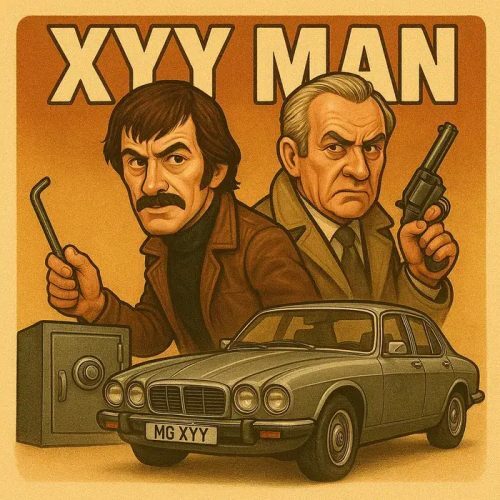4-minute read
Premise
If you liked gritty British crime shows with a twist, you’ll keep watching The XYY Man. It’s about Spider Scott, a reformed cat burglar forced back into a dangerous world. Think fast-paced thefts, secret agents, and moral grey areas. Plus, the show’s provocative idea that his extra Y chromosome makes him a criminal kept viewers hooked. It’s dark, tense, and packed with twists, making it a prime example of 70s UK crime drama. Each episode pulls you deeper into a tangled web of crime, espionage, and redemption. You just can’t look away, especially when the haunting theme music kicks in to signal another moral dilemma.
Characters
- William “Spider” Scott: A talented burglar desperate to go straight but keeps getting pulled back. His internal struggle is the heart of the show.
- Detective George Bulman: Eccentric, relentless, and driven. His obsession with Scott makes him both hero and villain.
- Derek Willis: Bulman’s dependable assistant. Calm and steady amid chaos.
- Maggie Parsons: Scott’s partner. Her patience keeps him sane amid the chaos.
- Fairfax: The shadowy MI5 guy manipulating events behind the scenes. Think of him as the show’s puppet master.
Production and Style
Produced by Granada, the show blends urban grit with spy intrigue. The use of real London locations, muted lighting, and tight editing creates a moody, tense atmosphere. Flashbacks and layered scenes add psychological depth. It’s noir before noir was fashionable, paced like a roller coaster. You get a hit of adrenaline with each episode, and a dash of moral uncertainty. The music, often haunting and sparse, really builds the suspense.
Series Structure and Episode Guide
The first season is a gripping three-part mini-series adapting Royce’s novel. The second season expands into ten original stories. It dives deeper into Scott’s criminal and espionage life, with escalating stakes.
Series 1 (1976)
- The Proposition: Fresh out of prison, Scott is blackmailed into stealing secrets. He wants normal life, but the world won’t let him.
- The Execution: He pulls off the theft, then finds himself hunted by foreign agents and cops. Things spiral fast.
- The Resolution: Loyalties shift, betrayals come to light, and Scott fights for survival as Bulman closes in.
Series 2 (1977)
- Friends and Enemies: Scott tries legit business, but old connections threaten his new life.
- The Missing Civil Servant: An official disappears, and Scott is pulled into a web of secrets and international plots.
- The Big Bang: Smuggling runs amok, and Scott gets caught in a deadly game.
- At the Bottom of the River: Evidence of sabotage emerges, and trust is shattered.
- When We Were Very Greedy: Corporate greed and personal vendettas collide, pulling Scott into violent rivalries.
- Now We Are Dead: Framed for murder, Scott must clear his name before it’s too late.
- Whisper Who Dares: Secrets unravel, revealing corruption, leaving Scott with impossible choices.
- Law and Order: Behind bars again, Scott is caught in a web of covert schemes.
- The Detrimental Robot: During a hostage crisis, Scott’s loyalty is tested as Bulman questions everything.
- A View to a Death: The series climaxes with Scott fighting for freedom amid espionage chaos.
Recurring Themes and Tone
Is Scott a product of his genes or environment? The extra Y chromosome symbolizes his internal turmoil. The show explores loyalty, corruption, and redemption. It’s suspenseful, with moral ambiguity fueling every plot twist. It’s not about science; it’s about character choice in a corrupt world.
The Bulman Universe
Strangers (1978–1982)
Following Bulman’s breakthrough, he leads covert ops in Manchester. The show grows darker, with complex characters and undercover missions. His famous quirks—gloves and Shakespeare quotes—became TV staples. That’s when Bulman fully established his gruff, enigmatic persona, making fans love him even more.
Bulman (1985–1987)
He’s retired but remains involved in shadowy investigations. Running a clock repair shop, Bulman battles morality, aging, and corruption. His journey from dogged cop to musing recluse is a slow burn, but everyone still watches for his sharp mind and quiet resilience.
Cultural Impact
The XYY Man kicked off a mini-universe of gritty police and spy dramas. Its focus on flawed heroes caught in systemic webs struck a chord. The show’s moral complexity and cutting-edge storytelling influenced future British crime series. Also, Bulman’s eccentricities became memes before memes were a thing. It made audiences think about authority—questioning who’s trustworthy and who’s dangerous.
Legacy and Relevance
Despite the discredited genetic premise, The XYY Man remains beloved. Its dark tone, moral questions, and layered characters still resonate. It helped shape an entire genre of morally ambiguous heroes navigating a shady world, leaving a mark on British TV history.
Scientific Context
The show popularized the idea that XYY syndrome causes crime. Today, scientists know this isn’t true. Most with an extra Y live normal lives. But back then, it made for compelling storytelling—though scientifically questionable.
Where to Watch
- The complete series is on DVD, so you can binge the whole thing. Perfect for nostalgic marathons.
- Full collections of Strangers and Bulman are also out there, so gather your mates and settle in.
Final Thoughts
The XYY Man stands out as a uniquely British crime saga. Its noir atmosphere, moral puzzles, and complex characters set the stage for a sprawling TV universe cherished by fans decades later. If you’re into flawed heroes, spy stories, and dark morality, this franchise is a must-watch.
